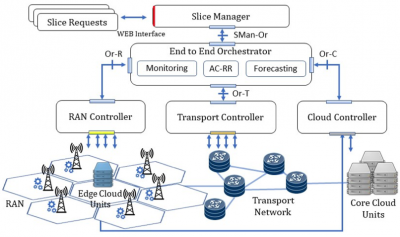Xavier Costa-Perez, Vincenzo Sciancalepore, Andres Garcia-Saavedra, Lanfranco Zanzi and Josep Xavier Salvat - NEC Laboratories Europe GmbH
Published: 30 Sep 2019


A note from the editor:
Overbooking: Every Business Has to Make a Profit
You have heard stories of airlines overbooking flights and then refuse passenger or offer alternate arrangements. In any business that has fixed assets but uncertainty in how those assets will be used by customers, overbooking can be a strategy to maximize profit while managing customer satisfaction. So, overbooking of network slice resources could potentially leverage new business models for mobile operators while optimizing their revenue from market. Here, overbooking can be seen as multiplexing the network slice resources and allocating more users than could be supported in the worst case for the given network capacity. A possible futuristic way forward would be to use loads of data about network resource usage by numerous services and predict the network slice resource allocation intelligently and improve the resource efficiency significantly based on user QoE rather than worst case use.
This month, Xavier Costa-Perez, Vincenzo Sciancalepore, Andres Garcia-Saavedra, Lanfranco Zanzi and Josep Xavier Salvat -from NEC Laboratories Europe GmbH, present how to create a realistic virtually dedicated infrastructure that meets the requirements of physical infrastructure by exploiting the concept of overbooking of network slice resources. Unlike airlines, overbooking of network slice resources can be effectively implemented by solving some interesting optimisation problem that maximises the revenue subject to some real time network constraints such as resource efficiency. The key concept here is to showcase the use case for artificial intelligence to automate the resource allocation and maximise the revenue without network performance degradation.
Enjoy this article, and find out how much revenue we could expect when integrating the concepts of overbooking with the network slice resources and as usual, your comments and feedback are more than welcome.
Muhammad Zeeshan Shakir
Editor

Overbooking 5G Networks





Xavier Costa-Perez, Vincenzo Sciancalepore, Andres Garcia-Saavedra, Lanfranco Zanzi and Josep Xavier Salvat - NEC Laboratories Europe GmbH
Motivation
The ever-wider availability of technologies such as mobile networks, artificial intelligence, cloud services, data analytics and ICT platforms are dramatically altering the way we live, work and interact – in what is usually referred to as the Fourth Industrial Revolution. The upcoming 5G disruptive technologies represent a key pillar for enabling this digital revolution unfolding around us.
According to the World Economic Forum estimations, the digital transformation of Telecommunications through 5G represents a $2 trillion opportunity [1]. 5G promises to simultaneously address the digitalization needs of a wide range of vertical industries with very diverse and stringent service requirements. To enable this vision, 5G aims to blend together software-defined networking (SDN), network function virtualization (NFV), mobile edge computing (MEC), network slicing (NS) and artificial intelligence (AI) technologies to create virtualized dedicated infrastructures (i.e. slices). Such slices are expected to meet in a differentiated manner the networking and computing requirements per vertical industry over the same physical infrastructure. The research challenges posed by this 5G vision are daunting, given the complexity of deploying and managing in real-time a 5G system simultaneously serving multiple advanced vertical services, e.g. autonomous driving, remote surgery or industry 4.0.
The first challenge to be addressed is the profound implication on resource management, as it entails an inherent trade-off between (i) the need for fully dedicated resources to support service customization, e.g. [2-5], and (ii) the dynamic resource sharing among services to increase resource efficiency and cost-effectiveness of the system, e.g. [6-11]. See Fig. 1 for an illustration. In [12] a first investigation of this trade-off is provided via an empirical study of resource management efficiency in network slicing. Building on substantial measurement data collected in an operational mobile network, the efficiency gap introduced by non-reconfigurable allocation strategies of different kinds of resources is quantified, from radio access to the core of the network, as well as the advantages of dynamic orchestration at different timescales. The results from this data-driven study show that 5G multi-vertical networks will be considerably more inefficient than current ones. The losses are quantified in almost one order of magnitude when considering isolated resources per vertical and as high as 20% even in fully centralized and shared scenarios.

Figure 1. Overbooking of Network Slice Resources
The Quest for New Revenue Models: Overbooking
Research work in the 5G area has pioneered novel revenue model solutions to address the aforementioned inefficiencies challenges on resource usage, e.g. [13-14]. Among them, Overbooking has been identified as one of the most promising ones.
5G leads mobile operators towards business models that, perhaps surprisingly, have a similar nature to successful yield management strategies popular in areas such as airline or hotel industries, and promise substantial gains in the revenue attained to mobile investments. In particular, in [3] the concept of slice overbooking is explored, i.e. accommodating the common practice in airline services of intentionally allocating more cargo than available capacity to the allocation of mobile network slices for 3rd-party services.
The challenge to adopt an orchestration system based upon the concept of slice overbooking is threefold: (i) when doing overbooking, resource deficit (and thus violations of system-level agreements) may occur; and so, in order to maintain the incentives for 3rd-parties (users) to join the system, a balance between overbooking and potential service disruption must be taken care of; (ii) there is a need to untangle the coupling between resource reservation and slice admission control decisions (AC-RR), which is further compounded by the heterogeneous nature of the resources required to build a slice across the whole system; (iii) appropriate use of monitoring information is needed to be able to adapt to behavioral dynamics of 3rd-party services embedded in network slices.

Figure 2. Network Slicing Orchestration system (c.f. [16])
Overbooking in Practice: Leveraging on AI and Open-Source
A complete orchestration solution is presented in [16]. As shown in Fig. 2, the orchestration solution is designed to manage end-to-end slices across multiple heterogeneous domains of the mobile ecosystem, including Radio Access Network, Transport Network and Cloud Data Centers. Such a design is based on a hierarchical control plane that governs multiple domain controllers across a mobile system using ETSI-compliant interfaces and data models. The system embeds a control engine in charge of making (i) admission control and (ii) resource reservation decisions by exploiting monitoring and forecasting information while maximizing overall revenues. Such a maximization of business revenues falls into the category of yield management, a mainstream business theory that studies fare management, access control and resource allocation. In the airline industry, the problem is to decide, based on the number of seat reservations, whether to accept or reject new requests considering that passengers may cancel, or even be “no-shows”, prior to the flight departure. Thus, overbooking is performed with associated penalties determined by a penalty-cost function.
Analogously to the airline example, this solution design exploits the fact that users rarely consumes all the resources they request. This enables the allocation of more tenants than those presumably allowed by the leftover capacity thereby gaining additional revenue from the slice resources multiplexing (i.e., overbooking). Clearly, an overly aggressive strategy may lead to resource deficit, discouraging potential users to join the system. This is properly addressed by designing a proper penalty-cost function.
Thus, we can formulate our problem as an optimization problem that aims at minimizing the estimated penalty while, at the same time, maximizing the overall obtained reward. This formulation is subject to different system constraints that make the problem tractable and consistent, such as (i) guaranteeing that the aggregate amount of spectrum, network link bandwidth, computing capacity, memory capacity allocated to slices is never surpassed, (ii) guaranteeing that accepted slices are allocated, at least, with the forecasted amount of resources and, at most, with the traffic requests, (iii) ensuring that all cloud resources (computing, memory, etc.) are allocated in the same data center.
Such a problem formulation can be mapped onto a Mixed Integer Linear Programming model, which can be solved with standard solvers (cplex) and algorithms (e.g. cutting-plane algorithms such as Benders decomposition method used in [16]).
Once the overbooking mechanism is grounded on an optimization formulation, provably-performing algorithms can achieve up to 3x revenue gains in several realistic scenarios built upon data from three real mobile operators. An experimental proof-of-concept validates the feasibility of implementing this approach with conventional mobile equipment on top of available open-source software, as shown in Fig. 3.

Figure 3. Network slicing overbooking in practice
Conclusion
While early 5G research and field-trials results are promising, we are far from fulfilling the holistic 5G vision. First 5G products will deliver mainly on the higher data rates promise. AI-based operations and managements solutions enabling the automation of 5G networks for a cost-efficient digitalization of industry verticals are still at its infancy and will require of a huge effort by the research community to reach commercial deployments during the next years.
Future research challenges to be addressed will comprise enabling novel business models, opening the mobile network ecosystem to new players fostering increased innovation and achieving a security level that can be fully trusted by mission-critical infrastructures.
References
- “Digital Transformation Initiative - Telecommunications Industry”, World Economic Forum White Paper, 2017
- P.Caballero et al.: “Network slicing games: Enabling customization in multi-tenant networks”, IEEE INFOCOM, 2017.
- P.Caballero et al.: “Network Slicing for Guaranteed Rate Services: Admission Control and Resource Allocation Games”, IEEE Transactions on Wireless Communications (TWC), 2018.
- B.Han, V.Sciancalepore, D.Feng, X.Costa-Pérez, H.D.Schotten: “A Utility-Driven Multi-Queue Admission Control Solution for Network Slicing.”, IEEE INFOCOM, 2019.
- P.Caballero et al.: “Network slicing games: Enabling customization in multi-tenant mobile networks”, IEEE/ACM Transactions on Networking (TON), 2019.
- V.Sciancalepore et al.: “Mobile traffic forecasting for maximizing 5G network slicing resource utilization”, IEEE INFOCOM, 2017.
- P.Caballero et al.: “Multi-Tenant Radio Access Network Slicing: Statistical Multiplexing of Spatial Loads”, IEEE/ACM Transactions on Networking (TON), 2017.
- D.Bega et al.: “DeepCog: Cognitive Network Management in Sliced 5G Networks with Deep Learning”, IEEE INFOCOM, 2019.
- V.Sciancalepore et al.: “STORNS: Stochastic Radio Access Network Slicing”, IEEE ICC, 2019.
- V.Sciancalepore et al.: “RL-NSB: Reinforcement Learning-based 5G Network Slice Broker”, IEEE/ACM Transactions on Networking (TON), 2019.
- C.Marquez et al.: “Resource Sharing Efficiency in Network Slicing”, IEEE Transactions on Network and Service Management (TNSM), 2019.
- C.Marquez et al.: “How Should I Slice My Network?: A Multi-Service Empirical Evaluation of Resource Sharing Efficiency”, ACM MOBICOM, 2018
- D.Bega et al.: “Optimising 5G infrastructure markets: The business of network slicing”, IEEE INFOCOM, 2017.
- D.Bega et al.: “A Machine Learning approach to 5G Infrastructure Market optimization”, IEEE Transactions on Mobile Computing (TMC), 2019.
- J.X.Salvat et al.: “Overbooking network slices through yield-driven end-to-end orchestration”, ACM CoNEXT. 2018.
Statements and opinions given in a work published by the IEEE or the IEEE Communications Society are the expressions of the author(s). Responsibility for the content of published articles rests upon the authors(s), not IEEE nor the IEEE Communications Society.


